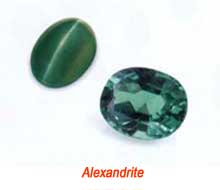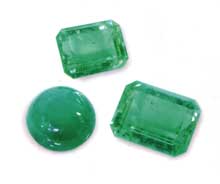| |
Madagascar -- seeds
of change
Madagascar
is the fourth largest island on Earth, and very poor. Until recenty the
struggling economy was dominated by agriculture, but with the recent discovery
of huge gem deposits, the Madagascan economy is changing.
The discovery of ruby and sapphire in Madagascar
has been compared to the 19th century gold rushed where people risked
life and limb pursuing their fortunes. Similarly the attraction of Madagascar
's recently discovered sapphire belt has drawn opportunists in their thousands.
The first clues to the richness of Madagascar
's subsoil were discovered in the southern part of the country in the
early nineties. But the first rushed on the island were caused in 1998
by the discovery of a sapphire belt at a tiny cattle-herding hamlet of
just 30 inhabitants, llakaka. The population of this town exploded, and
within a few months it grew to be a 50,000 strong commune. Buyers, sellers,
prospectors, and 300,000 hand-miners and opportunists all descended on
llakaka hoping to strike it rich. And who could blame them, a good quality,
large sapphire can fetch up to US$ 2,700, to the average Malagasy that's
the equivalent of 10 years work. The dealing of gemstones in
Madagascar had been, up until recently, largely unregulated; a free-for-all.
Much of the explotation within Madagascar's infant gem industry came in
the guise unscrupulous dealers. These dealers would then take the rubies
and sapphires home where the gems were cut and polished, after which they
could make a fortune selling them on to buyers abord. Other key factors,
which contributed to the lawless image of Madagascar's gem industry, were
inefficient and unregulated small-scale mining methods. The techniquesused,
mainly open pit mining, were damaging to the environment and also allowed
gems to be smuggled out with little economic benefit to the country. |
|
| |
To
help address these issues, the World Bank, in May 2003, approved a US$32
million loan agreement to help Madagascar manage its mineral resources
more effectively. The Madagascan government aims to reduce smuggling,
reform the sector's legal framework, establish administration offices
close to the mines, set up a certification program for dealers and attract
more investment from the private sector. As a result, mining has become
more restricted and regulated with buyers not being allowed onto many
sites. Investments are also being made to develop the lapidary arts. The
idea behind these reforms is to keep as much profit inside the country
as possible.
The llakaka region has
become well known as a source of fine blue, pink, blue-violet, violet,
purple, orange and yellow sapphires. Madagascan sapphires are considered
to be as attractive as their counterparts mined in Sri Lanka. The crystal
morphology, internal growth patterns, mineral inclusions, absorption spectra,
and trace-element contents of northern Madagascan gemstones are typical
of "basaltic-magmatic" sapphires. Madagascar produces about
half a ton of sapphires per year. It is estimated that it will take another
200 years to deplete the sapphire deposits in Madagascar. |
|
|
| |
However,
many deposits are thought to be some 100 meters below the surface, and
will have to be found through the use of professional mining techniques
rather than the haphazard hand mining methods that are employed on the
island today. Sapphires represent 95% of llakaka's mined gemstones and
have now flooded the world's market, but there are many more precious
stones to be had from the region; the who's who list of gems includes
tourmaline, garnet, chrysoberyl, alexandrite, topaz, andalusite, kyanite,
zircon, and semi-precious quartz.
After the sapphire the
most important gemstone being mined in Madagascar is the ruby. Two important
new ruby deposits in the east of the country - - Vatomandry and Andilamena
- - have made significant impacts on the world's gemstone industry. The
first Andilamena rubies were discovered in October 2000, but these were
not transparent and appeared rather dark, requiring heat treatment to
help lighten the color and remove the purple component. Better quality
rubies were found in January 2001, and within six weeks there were nearly
40,000 miners working in the Andilamena area. rubies from this region
occur as well-formed tabular crystals (which average 0.5 grameach) with
slightly rounded edges. Clean, attractive rubies showing fine deep red
colors coming from this deposit are rare. However some superb examples
have been mined weighing over 5 grams. |
|
| |
 |
At
virtually the same time as Andilamena, the Vatomandry
ruby deposit was discovered. Soon after this second
gem deposit was unearthed several thousand miners
moved in; however, the Malagasy government closed
the area to mining in February 2001, and all trading
and exporting of Vatomandory rubies was prohibited.
Many of the miners subsequently left the area, and
since then ruby production there has decreased substantially.
the majority of the rough produced weighs in at 0.1-0.3
grams, rough gemstones exceeding one gram are rare.
Although most of the rubies are purplish red, some
show an attractive color that is similar to fine Burmese
rubies, and a significant percentage of Vatomandry
rubies, and a significant percentage of Vatomandry
rubies are marketable without heat treatment.
The many miners trying
to get-rich-quick from the sapphire and ruby fields,
have left severe shortages of miners to work the country's
other gemstone deposits. However, mining at the llakaka
mines has declined. This is due in part to decreasing
reserves and the migration of miners who are moving
to other more gem rich areas in Madagascar. |
|
For
Madagascar, the past five years have been a hectic introduction
to the modern gem industry. Trying to balance crippling poverty
with new found wealth - - the old with the new - - the farmers
with the miners - - Madagascar's wild beginings in the gem
world things are slowly becoming more organized and controlled,
in the shape of Madagascar 's government taking more controlled
measures. Great gems and great bargains are to be had, but
for Madagascar, one of the poorest nations on earth, it is
time to reap the rewards.
Origins of emeralds
Colombian
emeralds are synonymous with quality, and they can sell for
almost twice as much as their Brazilian, Zambian or Zibabwean
counterparts. Unsurprisingly, the financial aspect of the
Colombia gem trade has attracted a lot of unwanted attention.
Colombian drug cartels, along with their powerful acolytes
have devised various scams to exploit the world's demand for
top price Colombian emeralds. However, with last month's announcement
of a major breakthrough in gemstone identification, the days
of illegal trading are numbered. |
|
|
|
| |
The
advances in gemstone analysis came from scientists in France who discovered
a new method for tracing the origins of emeralds: using infrared equipment
to examine their oxygen isotopes. Put simply, every individual gemstone
has its own internal molecular structure - - much like fingerprints in
humans - - and these difference in structure are characteristic of the
region where the gemstone was mined. So by looking at a gem's infrared
spectrum and using it to examine the molecular structure, scientists can
now determine the precise origin of a gemstone.
Although this method isn't
entirely new it has beenimproved to a point where it is commercially viable.
Measuring these difference in the past required specialist equipment and
also entailed vaporizing a tiny amount of the gem, not popular with either
gem dealers or buyers. However, the advances made in France means that
there is now a way to analyze an emerald using rouline gem laboratory
equipment without damaging the gemstone. In their extensive research into
the method's infallibility scientists collected samples from 46 emerald
mines worldwide, and concluded that they fell into five different groups
that corresponded to geographical regions. The skeptics of this new technique |
|
|




